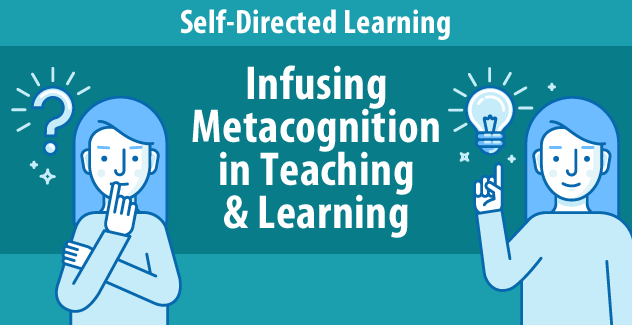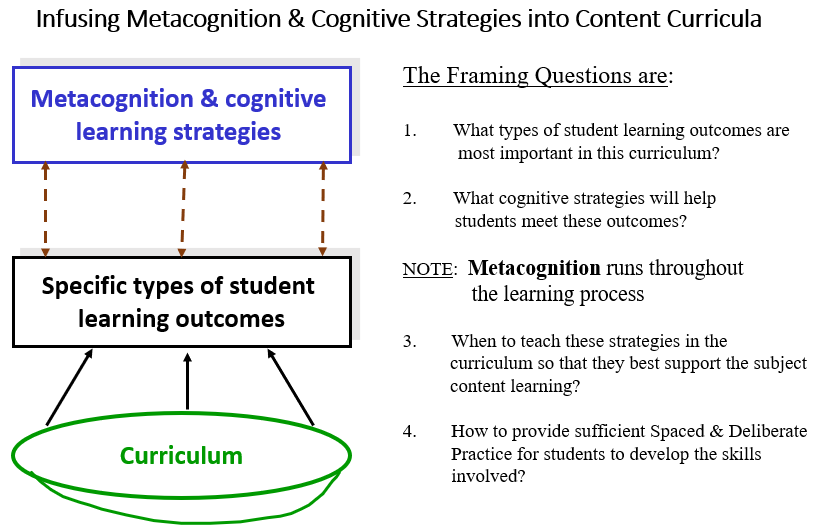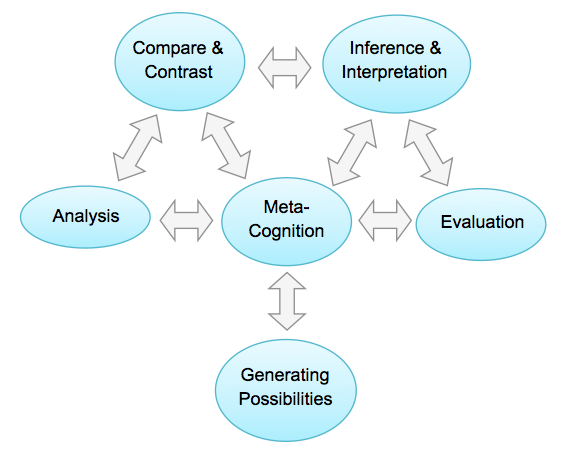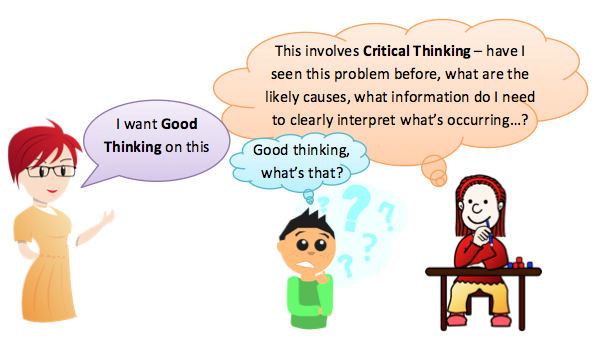
This is a series of five blog posts on Self-Directed Learning (SDL), which has become somewhat of a vogue term in the present educational context. For example, the Partnership for 21st Century Skills identified SDL as one of the life and career skills necessary to prepare students for post-secondary education and the workforce.
In the previous post, an Evidence-based Pedagogic Framework for developing SDL was established (he says hopefully).
In this third post, the methodology for the systematic infusion and facilitation of metacognitive strategies is outlined and illustrated.
An Infusion Model for Metacognitive Strategies
Veenman (1998), in reviewing the literature, identified three fundamental principles that are necessary for successful metacognitive instruction:
- embedding metacognitive instruction in the content matter to ensure connectivity,
- informing learners about the usefulness of metacognitive activities to make them exert the initial extra effort, and
- prolonged training to guarantee the smooth and maintained application of metacognitive activity.
He suggests following the WWW & H rule (What to do, When, Why, and How) in implementing these principles (p.9). I have developed the following design model and heuristics that can help guide this process:
 |
In conducting a curriculum review, first identify the important learning outcomes that require metacognitive and cognitive activity (e.g., critical thinking skills), and when and where they are taught in the curriculum. You may need to re-write certain learning outcomes to make these ‘thinking skills’ explicit. This provides the guide for introducing specific strategies that will aid students in developing such skills. Invariably, metacognition runs throughout the learning process and needs to be taught early in the program.
What Students Need
To become more self-directed in their learning, students need to be able to:
- Develop Metacognitive Capability
- Thoughtfully use Cognitive Learning Strategies and Skills
- Motivate themselves to use this capability and skill sets
However such competence requires students to have a clear understanding of what this entails in terms of the strategies and skills involved and how they work, in order to use them effectively as tools for learning. There is often an assumption that thinking is simply common sense. Well, even if it is, and I don’t think it is, it’s not that common.
Thinking was not something I learned from my 15,000 hours at school, which is the approximate number of hours we spend at school according to Rutter et al (1982). Also, my teachers can be easily forgiven, if Wagner’s (2010) conclusion is correct:
In schools, critical thinking has long been a buzz phrase. Educators pay lip service to its importance, but few can tell me what they mean by the phrase or how they teach and test it… (p.16)
For the most part, teachers haven’t been trained to teach students how to think. (xxiv)
Hence, while metacognition and cognitive (thinking) skills have high impact on student attainment, Ambrose (2010) notes:
Unfortunately, these metacognitive skills tend to fall outside the content area of most courses, and consequently they are often neglected in instruction. (p.191)
What is Good Thinking?
In the first post, I made reference to the importance of Good Thinking as a key underpinning competence for SDL. While Metacognition is an essential part of good thinking, there is also the rest of thinking. If metacognition can be referred to as ‘thinking about thinking’, then what is thinking?
In most basic terms, thinking is goal directed cognitive activity, which seems to occur not just at a conscious level (e.g., “I must think this through”), but also subconsciously and unconsciously. There is, despite differences in perspective and terminology in the literature, strong agreement that thinking is crucial to the quality of human learning. As Paul (1993) summarized:
Thought is the key to knowledge. Knowledge is discovered by thinking, analyzed by thinking, organized by thinking, transformed by thinking, assessed by thinking, and, most importantly, acquired by thinking. (vii)
However, thinking does not occur in isolation; but rather through connecting and making sense of information, which ultimately (if successful) is retained as neurologically useful mental models in long-term memory. As Willingham (2009) summarized:
Thinking occurs when you combine information (from the environment and long-term memory) in new ways…That combining happens in working memory. (p.11)
First you should know that much of the time when we see someone apparently thinking, he or she is actually engaged in memory retrieval…memory is the cognitive process of first resort. (pp. 28-29)
Hence…we must ensure that students acquire background knowledge parallel with practicing critical thinking skills (p.22)
Of significance, then, according to Willingham, “Memory is the residue of thought” (p.47). When folk, even some teachers, talk about getting students to think and not memorize they fail to understand how the learning process really works.
What is even more significant is that teachers must teach such important knowledge about learning, so that students also possess these understandings, which are so important for developing SDL.
A Practical Model of Thinking
The task of framing what constitutes good thinking, and how this works as an internal process is a challenging one. However, research suggests that while there is variation in how humans experience phenomena in the world based on prior experience, belief systems and selective perception, etc., our common human apparatus and need orientation typically results in shared ways of experiencing the world. As Marton (1981) summarized:
…we have repeatedly found that phenomena, aspects of reality, are experienced (or conceptualized) in a relatively limited number of qualitatively different ways. (p.181)
In terms of how we think this means that while, for example, psychologists may solve problems in some qualitatively differently ways from engineers, both at the individual and collective level, there is much similarity in the types of cognitive activity involved. For example, they will need to analyse situations (e.g., cases), make comparison and contrast with similar cases, build up inferences and interpretations from ongoing perceptions and data accumulation, generate possible solutions and decide action based on chosen criteria. Around this swirl of cognitive activity, there will be an overall monitoring of what is going on, typically referred to as metacognition. The summary model is depicted in Figure 1.1: Sale (2015) Model of Types of Thinking, and the typical cognitive heuristics involved are outlined in Table 1.1: Cognitive Heuristics of Types of Thinking. Note that the cognitive heuristics for each type of thinking are the essential framing questions to be negotiated in making sense of information and building understanding.
 |
Fig 1.1: Sale (2015) Model of Types of Thinking
In this model, analysis, compare & contrast, inference & interpretation and evaluation are typically employed during critical thinking; whereas generating possibilities, as the term implies, is predominantly employed in creative thinking. Metacognition refers to the awareness of and ability to monitor and control one’s cognitive and affective processes in-order to enhance thinking and learning (as you know)!
|
|
Table 1.1: Cognitive Heuristics of Types of Thinking
The Need for Explicit Teaching of Metacognition
Schraw et al (2006) urge educators to provide explicit instruction in metacognitive and cognitive strategies. They emphasize that such strategy training needs to emphasize how to use strategies, when to use them, and why they are beneficial. The most significant gains in student achievement result when students are taught the use of metacognitive strategies in explicit ways.
The characteristics of explicit teaching include:
- Direct instruction on the strategies—when and how to use them. This requires clear explanation and demonstration on how metacognition and cognition work, and the benefits of using the strategies for learning. This can be illustrated with a range of examples and stories (both yours, others and the students)
- Modelling the strategies – ‘Thinking aloud’, verbalizing the processes of good thinking
- Providing repeated opportunities for using the strategies in spaced (guided and independent) practice formats.
In this process, it’s really important to ensure that good thinking is clearly and explicitly modelled through a range of relevant examples to the subject topic. As Sheppard et al (2009) recognized:
…teachers have to make their own intellectual processes (their performances) visible. This means that the teacher-expert has to make visible to learners the otherwise invisible processes of thinking that underlie complex cognitive operations…
Teachers have to articulate and demonstrate rather than assume the thought processes they want students to learn. (p.188)
Equally important, is the need to make students thinking visible. As Ritchhart, Church & Morrison (2011) point out:
We need to make thinking visible because it provides us with the information we as teachers need to plan opportunities that will take students’ learning to the next level and enable continued engagement with the ideas being explored. (p.27)
In the process of helping students to build sufficient understanding of what constitutes good thinking and how to develop this capability, some key instructional strategies are particularly useful. For example, making thinking visible (both student thinking and teacher thinking) is essential, but this must be done consistently and sufficiently for it to become cemented in long term memory and established as an everyday practice when good thinking is required.
In order to facilitate this effectively, the key terminology relating to the various heuristics of the types of thinking need to become part of the language of learning (to consolidate a language of thinking). For example, I often hear teachers, who I assume are seeking to encourage student thinking, use terms like “What are your comments on this” or “Let’s discuss this”—even “I want good thinking on this.” This latter example assumes that students actually have a mental model (schemata) of what constitutes thinking. However, in reality this may vary widely (e.g., Fig. 1.2: Mental Models of Thinking). If they have no prior useful mental model, then they are either totally blank or in the process of just commenting, which typically results in statements like, “It’s ok”, or “I don’t like it much”, which has little underpinning thoughtful analytical or evaluative base to it.
 |
Fig. 1.2: Mental Models of Thinking
In contrast, when students understand the different types of thinking, and the cognitive heuristics involved, they can respond thoughtfully (no pun intended) to their teacher’s systematic use of language to specifically cue these types of thinking. This provides the essential modeling and practice to develop competence over time. For example, a possible teacher question in a situation of comparing two solutions to a problem situation might be something like, “Comment on these two proposed solutions.” However, to provide the essential structuring to cue and develop the desired thinking process, a better questioning approach would involve something along the lines of, “Let’s compare and contrast these two solutions… identify what is similar and different in each… what is significant about the differences in the solutions… what’s important about these differences… how do these differences impact the problem situation we are trying to address?”
Through the use of appropriate cuing questions, in which the types of thinking are naturally infused into the content of the topic, students will quickly become familiar with the ‘language of thinking.’ For example, when asked to evaluate options, whatever the subject context, they will have already internalized that this requires the deriving of relevant criteria to be used in evaluation, the likely prioritizing of these criteria in terms of relative importance in making the decision, and finally to apply the criteria, based on the available information, to the option or range of options.
Questioning, is a key strategy in developing all types of thinking. As the famous success coach Anthony Robbins (2001) wrote:
Questions are the primary way we learn virtually everything.
Thinking itself is nothing but the process of asking and answering questions.
(pp.179-8)
To further build understanding and competence, it is essential to provide appropriate practice through specific performance-based learning tasks that incorporate the types of thinking to be developed. This can be done in two main ways:
- Specific activities that require planning, monitoring and evaluating learning (e.g., projects; case-based learning) (see Table 1.2: Example of a draft performance task, for an illustration of how different types of thinking can be structured into a project brief)
- Periodically get students to do metacognitive checks on how they have been learning at designated stages in the task activity
This entails getting students to reflect on and document the quality of their thinking and other aspects of self-regulation (e.g., emotions, beliefs), identifying challenges faced in their learning, how they tackled these, the strategies used, and their effectiveness (or otherwise).
 |
Table 1.2: Example of a draft performance task
I know this has been a ‘meaty’ post, so you will have displayed good volition—even motivation—on completion.
In the next post, I will outline key motivational strategies for promoting SDL. As pointed out in the first post, without motivation, there may be little by way of purposeful self-direction.
References
Ambrose, S.A., et al. (2010) How Learning Works: 7 Research-Based Principles for Smart Teaching. Jossey-Bass, San Francisco.
Marton, F., (1981) ‘Phenomenography – Describing conceptions of the world around us’, in Instructional science 10, 1981, 177-200. Elsevier Scientific Publishing Company, Amsterdam.
Paul, R. W., (1993) Critical Thinking: Foundation for Critical Thinking, Santa Rosa, CA.
Paul, R., Niewoehner, R., Elder, L., (2006) The Thinker’s Guide to Engineering Reasoning. Foundation for Critical Thinking, Tomales, CA.
Ritchhart, R., Church, M., & Morrison, K., (2011) Making Thinking Visible. Jossey-Bass, San Francisco.
Robbins, A., (2001), Unlimited Power. Pocket books, London.
Rutter, M. (1982) Fifteen Thousand Hours: Secondary Schools and Their Effects on Children. Harvard University Press, Cambridge MA.
Sheppard, S. D., et al., (2009), Educating Engineers: Designing for the Future of the Field. San Francisco: Jossey-Bass.
Schraw, G. et al. (2006) Promoting self-regulation in science education: Metacognition as part of a broader perspective on learning. Research in Science Education, 36, 111-139
Wagner, T., (2010) The Global Achievement Gap. Basic Books, New York.
Willingham, D. T., (2009) Why Don’t Students Like School: A Cognitive Scientist Answers Questions About How the Mind Works and What It Means for the Classroom. Jossey-Bass, San Francisco.
Veenman, V.J. et al. (2006) Metacognition and Learning: conceptual and methodological considerations. Metacognition Learning (2006) 1: 3-14
 About Dennis Sale: Dennis Sale is the author of Creative Teaching: An Evidence-Based Approach (Springer, 2015), the first book to demystify creative teaching and make explicit how it works at the level of specific teaching practices, underpinned by the creative application of cognitive scientific principles. He has worked in all sectors of the British education system, spending some 3 decades training and mentoring over 3000 teaching/training professionals in many countries and cultural contexts. Presently he is Senior Education Advisor for Singapore Polytechnic, and Principal Investigator for a 2-year Ministry of Education research project, entitled ‘Enhancing Student’s Intrinsic Motivation: An Evidence-Based Approach’.
About Dennis Sale: Dennis Sale is the author of Creative Teaching: An Evidence-Based Approach (Springer, 2015), the first book to demystify creative teaching and make explicit how it works at the level of specific teaching practices, underpinned by the creative application of cognitive scientific principles. He has worked in all sectors of the British education system, spending some 3 decades training and mentoring over 3000 teaching/training professionals in many countries and cultural contexts. Presently he is Senior Education Advisor for Singapore Polytechnic, and Principal Investigator for a 2-year Ministry of Education research project, entitled ‘Enhancing Student’s Intrinsic Motivation: An Evidence-Based Approach’.
Dennis is a long time SoftChalk user and has conducted workshops for educators showcasing SoftChalk as a way to improve their lessons.



One Comment
Melvin Manlincon
This is very informative approach in teaching and learning.